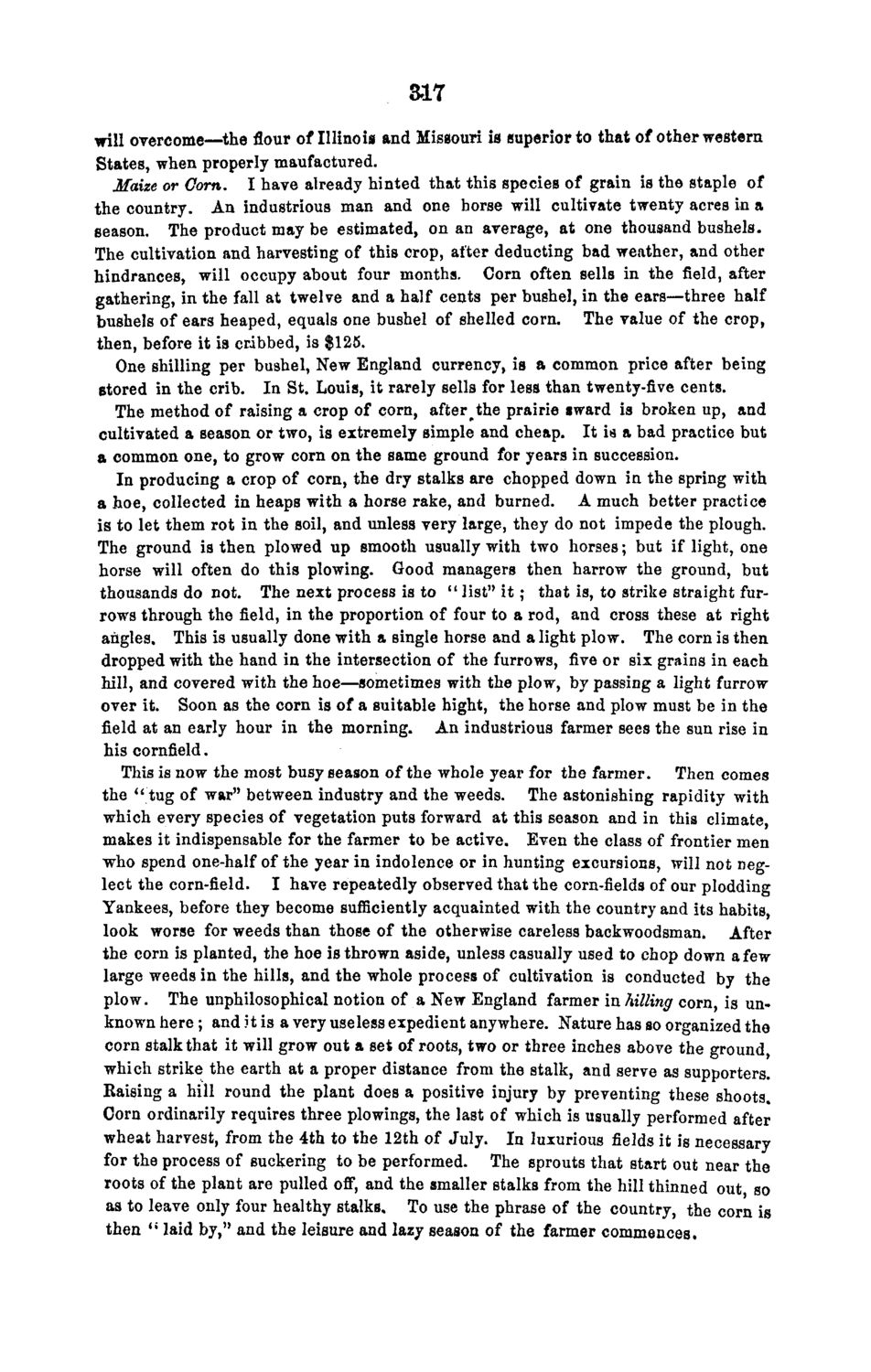| |
| |
Caption: Board of Trustees Minutes - 1868
This is a reduced-resolution page image for fast online browsing.

EXTRACTED TEXT FROM PAGE:
317 will overcome—the flour of Illinois and Missouri is superior to that of other western States, when properly maufactured. Maize or Corn. I have already hinted that this species of grain is the staple of the country. An industrious man and one horse will cultivate twenty acres in a season. The product may be estimated, on an average, at one thousand bushels. The cultivation and harvesting of this crop, after deducting bad weather, and other hindrances, will occupy about four months. Corn often sells in the field, after gathering, in the fall at twelve and a half cents per bushel, in the ears—three half bushels of ears heaped, equals one bushel of shelled corn. The value of the crop, then, before it is cribbed, is $125. One shilling per bushel, New England currency, is a common price after being stored in the crib. In St. Louis, it rarely sells for less than twenty-five cents. The method of raising a crop of corn, afterthe prairie sward is broken up, and cultivated a season or two, is extremely simple and cheap. It is a bad practice but a common one, to grow corn on the same ground for years in succession. In producing a crop of corn, the dry stalks are chopped down in the spring with a hoe, collected in heaps with a horse rake, and burned. A much better practice is to let them rot in the soil, and unless very large, they do not impede the plough. The ground is then plowed up smooth usually with two horses; but if light, one horse will often do this plowing. Good managers then harrow the ground, but thousands do not. The next process is to " list" i t ; that is, to strike straight furrows through the field, in the proportion of four to a rod, and cross these at right angles. This is usually done with a single horse and a light plow. The corn is then dropped with the hand in the intersection of the furrows, five or six grains in each hill, and covered with the hoe—sometimes with the plow, by passing a light furrow over it. Soon as the corn is of a suitable hight, the horse and plow must be in the field at an early hour in the morning. An industrious farmer sees the sun rise in his cornfield. This is now the most busy season of the whole year for the farmer. Then comes the "tug of war" between industry and the weeds. The astonishing rapidity with which every species of vegetation puts forward at this season and in this climate, makes it indispensable for the farmer to be active. Even the class of frontier men who spend one-half of the year in indolence or in hunting excursions, will not neglect the corn-field. I have repeatedly observed that the corn-fields of our plodding Yankees, before they become sufficiently acquainted with the country and its habits, look worse for weeds than those of the otherwise careless backwoodsman. After the corn is planted, the hoe is thrown aside, unless casually used to chop down a few large weeds in the hills, and the whole process of cultivation is conducted by the plow. The unphilosophical notion of a New England farmer in hilling corn, is unknown here ; and it is a very useless expedient anywhere. Nature has so organized the corn stalk that it will grow out a set of roots, two or three inches above the ground which strike the earth at a proper distance from the stalk, and serve as supporters. Kaising a hill round the plant does a positive injury by preventing these shoots. Corn ordinarily requires three plowings, the last of which is usually performed after wheat harvest, from the 4th to the 12th of July. In luxurious fields it is necessary for the process of suckering to be performed. The sprouts that start out near the roots of the plant are pulled off, and the smaller stalks from the hill thinned out so as to leave only four healthy stalks. To use the phrase of the country, the corn is then " laid by," and the leisure and lazy season of the farmer commences.
| |